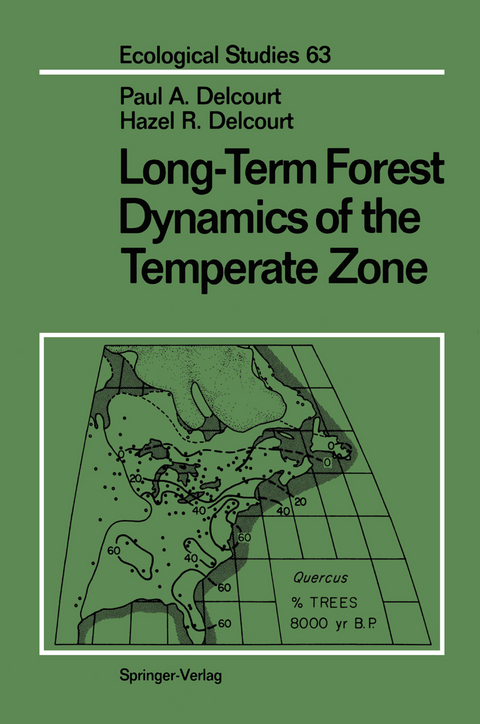
Long-Term Forest Dynamics of the Temperate Zone
Springer-Verlag New York Inc.
978-1-4612-9136-7 (ISBN)
The synthesis presented in this volume is a direct outgrowth of our ten-year FORMAP Project (Forest Mapping Across Eastern North America from 20,000 yr B.P. to the Present). Many previous research efforts in paleoecology have used plant-fossil evidence as proxy information for primarily geologic or climatic reconstructions or as a bio stratigraphic basis for correlation of regional events. In contrast, in this book, we deal with ecological questions that require a holistic perspective that integrates the interactions of biota with their dynamically changing environments over time scales up to tens of thousands of years. In the FORMAP Project, our major research objective has been to use late-Quaternary plant-ecological data sets to evaluate long-term patterns and processes in forest de velopment. In order to accomplish this objective, we have prepared subcontinent-scale calibrations that quantitatively relate the production and dispersal of arboreal pollen to dominance in the vegetation for the major tree types of eastern North America. Quantification of pollen-vegetation relationships provides a basis for developing quan titative plant-ecological data sets that allow further ecological analysis of both individual taxa and forest communities through time. Application of these calibrations to fossil pollen records for interpreting forest history thus represents a fundamental step beyond traditional summaries based upon pollen percentages.
1. The Nature of Long-Term Vegetational Change.- Long-term patterns and processes in forest communities.- Spatial and temporal scale.- Quaternary environmental changes as forcing functions.- Anthropogenic influences.- Models of stability and dynamics of forest communities.- Conclusions.- 2. Modern Pollen-Vegetation Relationships.- Production and dispersal of pollen grains.- Calibration of the relationship of modern pollen assemblages to extant forests.- The representation of temperate and boreal tree taxa in modern pollen samples and forest vegetation.- Conclusions.- 3. Reconstructing Long-Term Forest Changes From Fossil-Pollen Data.- Comparison of quantitative techniques for reconstruction of past vegetation.- A case study in comparison of taxon calibrations, modern analogue techniques, and simulation models as different approaches for quantifying past vegetation.- Generating late-Quaternary plant-ecological data sets.- Conclusions.- 4. Vegetation Map Patterns at the Biome Level.- Constructing paleogeographic maps.- Paleovegetation maps for eastern North America: 20,000 yr B.P. to the present.- Patterns of paleoclimate inferred from maps of paleovegetation.- Conclusions.- 5. Tree Population Dynamics During the Past 20,000 Years.- Population trajectories through time.- Contoured paleo-dominance maps for major tree taxa in eastern North America.- Conclusions.- 6. Late-Quaternary MIgrational Strategies of Tree Species.- Ecological areography.- Migrational strategies of tree taxa.- Late-Quaternary patterns and processes of migration.- Geographic and temporal variation in late-Quaternary migration rates.- Conclusions.- 7. The Role of Competition in Long-Term Forest Dynamics.- The ghost of competition past.- Use of pollen accumulation rates (PAR) for estimating changes in tree populations.- Black ash and hornbeam: A case study in late-glacial and early-Holocene competition.- Potential versus realized niches.- Conclusions.- 8. Gradient Analysis, Ecotones, and Forest Communities.- Direct gradient analysis.- DECORANA ordination of late-Quaternary ecoclines.- Conclusions.- 9. Quaternary Landscape Ecology.- Integration of pattern and process in vegetation, climate, and geomorphology.- Paleohydrology and Quaternary vegetation of the Interior Low Plateaus.- Quaternary landscape evolution in the southern Appalachian Mountains.- Landscape transformation in the deglaciated Great Lakes region.- Conclusions.- 10. Long-Term Forest Dynamics of the Temperate Zone.- Late-Quaternary vegetational and climatic history of Europe.- Late-Quaternary distributional histories of European tree genera.- Conclusions.- References.- List of late-Quaternary sites used in the FORMAP Project.
| Reihe/Serie | Ecological Studies ; 63 |
|---|---|
| Zusatzinfo | XIII, 439 p. |
| Verlagsort | New York, NY |
| Sprache | englisch |
| Maße | 155 x 235 mm |
| Themenwelt | Naturwissenschaften ► Biologie ► Botanik |
| Naturwissenschaften ► Biologie ► Ökologie / Naturschutz | |
| Naturwissenschaften ► Geowissenschaften ► Mineralogie / Paläontologie | |
| ISBN-10 | 1-4612-9136-4 / 1461291364 |
| ISBN-13 | 978-1-4612-9136-7 / 9781461291367 |
| Zustand | Neuware |
| Haben Sie eine Frage zum Produkt? |
aus dem Bereich


